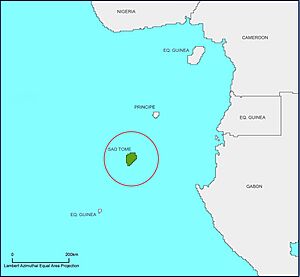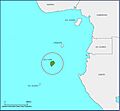São Tomé free-tailed bat facts for kids
The
Quick facts for kids São Tomé free-tailed bat |
|
|---|---|
| Conservation status | |
| Scientific classification | |
| Genus: |
Mops
|
| Species: |
tomensis
|
 |
|
| range | |
| Synonyms | |
|
|
The São Tomé free-tailed bat (Mops tomensis) is a special kind of bat. It belongs to the Molossidae family, also known as free-tailed bats. This bat is found only on the islands of São Tomé and Príncipe. It lives in dry and moist savanna areas, and sometimes even in farm plantations. Sadly, it's in danger because its home is disappearing. So far, scientists have only ever seen three of these bats!
Contents
About the São Tomé Free-Tailed Bat
When Was This Bat Discovered?
Scientists first officially described the São Tomé free-tailed bat as a new species in 1993. When it was first found, they thought it belonged to a different group of bats called Tadarida. Its full scientific name back then was Tadarida (Chaerephon) tomensis.
What Does Its Name Mean?
The second part of its scientific name, "tomensis", means "belonging to Tomé." This is because the very first bat of this kind ever found was on the island of São Tomé and Príncipe. Scientists think this bat might be related to another bat called Gallagher's free-tailed bat.
What Does the São Tomé Bat Look Like?
Like other bats in the Mops group, the São Tomé free-tailed bat has ears that are connected by a thin piece of skin. It's a small bat, with its forearm (part of its wing) being about 38.5 millimeters (1.5 inches) long. Each bat weighs about 7.2 grams (0.25 ounces), which is super light!
Its ears have round tips and are wider than they are tall. It has a small, rectangular part on its ear called an antitragus. The tiny part inside the ear, called the tragus, is very small. Its wings are long and narrow, and the wing skin is almost clear and whitish. The fur on its back is dark brown, while the fur on its belly is a lighter brown. This bat has 30 teeth in total.
Where Does the São Tomé Bat Live?
The very first São Tomé free-tailed bat ever found was about 3 kilometers (1.9 miles) northwest of Guadalupe, São Tomé and Príncipe, near a place called Praia das Conchas. Another one was found near Água Izé.
These bats have been seen in open savanna forests with big baobob trees (like near Praia das Conchas). They have also been found in humid forests (like near Água Izé). Sadly, the forest where the bat was found near Água Izé might have been cut down. This land was likely changed into cocoa farms.
Protecting the São Tomé Bat
Why Is This Bat Endangered?
The São Tomé free-tailed bat is currently listed as an endangered species by the IUCN. This means it's at a very high risk of disappearing forever. As of 2019, the only bats of this species that scientists have ever seen are the three that were used to describe the species back in 1993.
It's possible that this bat is also struggling because it has to compete for food and homes with another bat called the little free-tailed bat. Protecting the places where these bats live is very important to help them survive.
Images for kids



